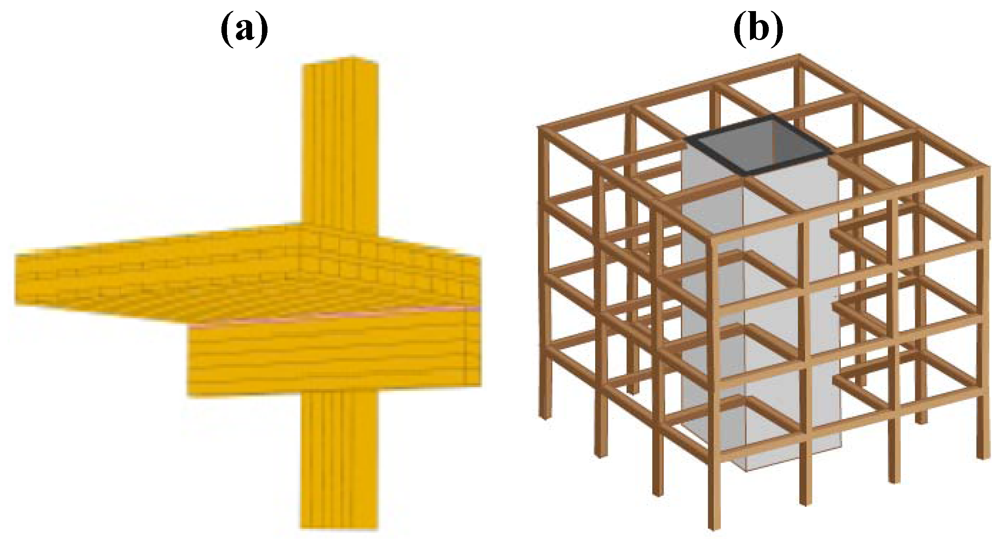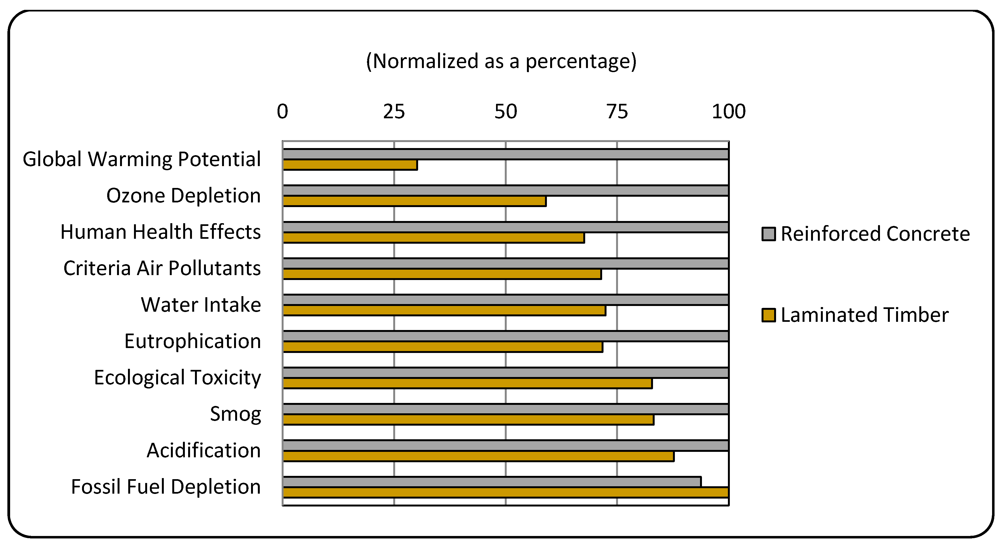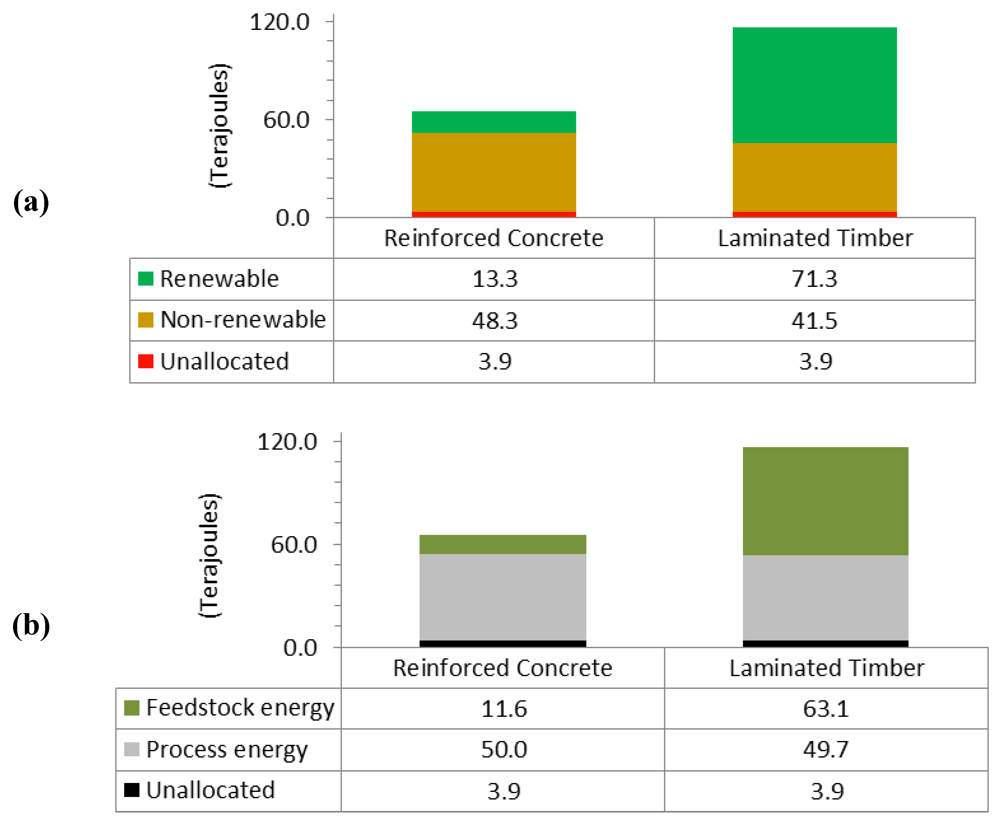A Comparative Cradle-to-Gate Life Cycle Assessment of Mid-Rise Office Building Construction Alternatives: Laminated Timber or Reinforced Concrete
Abstract
:1. Introduction
2. Methodological Framework

| Quantitative (numerically defined within study) | Qualitative (discussed based on case study & literature reviews) |
|---|---|
|
|
Study Limitations
3. Results
3.1. Functional Units and Bill of Materials
| Concrete design | Timber design | Functional unit | Notes & assumptions |
|---|---|---|---|
| Gypsum Wall Board | Gypsum Wall Board | 0.09 m2 (1 ft2) | 13 mm (½”) thick, includes tape, mud, screws @ 406 mm (16”) O/C studs, corner bead is not included |
| Steel Stud Framing | – | 0.09 m2 (1 ft2) | 33 mm galvanized studs @ 610 mm (24”) O/C, screws included |
| – | Wood Stud Framing | 0.09 m2 (1 ft2) | 38 × 89 mm (2” 4” nominal), untreated, kiln-dried @ 406 mm (16”) O/C, galvanized steel nails included |
| – | BioPreserve Soyguard Wood Sealer | 9.29 m2 (100 ft2) | Applied to exterior exposed wood only, repeated every 2 years |
| Anonymous R-13 Insulation | Anonymous R-13 Insulation | 0.09 m2 (1 ft2) | 89 mm (3−½) thick |
| Spray Foam Insulation | – | 1 m2 | 3 cm thick, closed cell polyurethane with H2O/CO2 blowing agent |
| Slab-on-Grade * | Slab-on-Grade * | 0.09 m2 (1 ft2) | 102 mm (4”) thick, f’c = 21 MPa, 15% & 20% fly ash cement mixes considered, assumed 0.908 kg/m2 (1.67 lbs/yd2) of reinforcing steel |
| Below-Grade Foundation Walls & Spread Footings * | Below-Grade Foundation Walls & Spread Footings * | 0.09 m2 (1 ft2) | 203 mm (8”) thick, f’c = 21 MPa, 15% & 20% fly ash cement mixes considered, assumed 23.9 kg/m2 (44 lbs/yd2) of reinforcing steel |
| Above-Grade Walls, Beams, Slabs, Drop Panels & Slab Bands * | – | 0.0283 m3 (1 ft3) | f’c = 28 MPa, 15% & 20% fly ash cement mixes considered, average of 86.2 kg/m3 (145 lbs/yd3) of reinforcing steel assumed |
| Columns & Shear Cores/Walls * | Elevator & Stair Concrete Shear Cores/Walls * | 0.0283 m3 (1 ft3) | f’c = 34 MPa, 15% & 20% fly ash cement mixes considered, average of 172.4 kg/m3 (290 lbs/yd3) of reinforcing steel assumed |
| – | Cross-Laminated Timber Walls & Floors | 1 m3 | 38 × 140 mm (2” × 6” nominal) untreated, kiln-dried, MPB-killed lodgepole pine lumber, bonding adhesives are included |
| – | Glulam Beams & Columns | 1 m3 | Standard grades and dimensions, untreated, kiln-dried, MPB-killed lodgepole pine lumber, bonding adhesives are included |
| Curtain Wall | Curtain Wall | 1 m2 | Viewable & spandrel glazing considered, viewable units assumed double-glazed, low-e, argon gas filled |
| – | Generic Cedar Siding | 0.09 m2 (1 ft2) | Bevelled, 13 mm (½ - can be changed to 0.5 if required”) thick, 150 mm (6”) wide, galvanized nails @ 41 cm (16”) O/C, 1 coat primer & 2 coats stain (stain reapplied every 10 years) |
| Material group | Unit of measurement | Concrete design | Timber design |
|---|---|---|---|
| Foundation | |||
| Footings | (m3 of concrete) | 1,408 | 1,408 |
| Slab-on-grade | (m3 of concrete) | 416 | 416 |
| Foundation walls | (m3 of concrete) | 834 | 834 |
| Below-grade columns | (m3 of concrete) | 151 | 151 |
| P2, P1 & ground floor slabs | (m3 of concrete) | 3,253 | 3,253 |
| Superstructure | |||
| Primary shear walls & cores | (m3 of concrete) | 1,293 | 1,293 |
| Vertical load-bearing walls | (m3 of concrete or CLT) | 181 | 128 |
| Above-grade floors & roof | (m3 of concrete or CLT) | 3,628 | 2,950 |
| Above-grade columns | (m3 of concrete or glulam) | 268 | 122 |
| Beams & roof parapet | (m3 of concrete or glulam) | 166 | 947 |
| Wood sealer | (m2) | – | 1,586 |
| Building Enclosure | |||
| Curtain wall | (m2) | 2,415 | 2,415 |
| Cedar siding | (m2 of 13 mm thickness) | – | 13,374 |
| ccSPF insulation | (m3) | 2,134 | – |
| Building Enclosure | |||
| R-13 insulation | (m3) | 258 | 115 |
| Steel stud framing | (m2 @ 406 mm O/C) | 1,617 | – |
| Wood stud framing | (m2 @ 406 mm O/C) | – | 1,617 |
| Gypsum wall board | (m2 of 13 mm thickness) | 1,929 | 1,929 |
3.2. Life Cycle Impact Analysis: Building Design Comparison

3.3. Embodied Energy

3.4. Uncertainty Analysis
3.5. Sensitivity Analysis
3.5.1. Lower Impact Concrete Mix: A 5% Increase in Fly Ash Content
3.5.2. Laminated Timber Material Quantities: An Increase of 10%

4. Discussion
4.1. LCA of Wood Products
4.1.1. Adhesives
4.1.2. Carbon Accounting
4.2. EE and GWP: Analysis and Literature Comparison
| Study authors | Embodied energy (GJ/m2) | GWP (kg CO2 eq./m2) |
| Reinforced concrete frame | ||
| Cole, R.J. [23] | 4.93 | – |
| Hood, I.W. [24] | 4.26 | – |
| Cole, R.J.; Kernan, P.C. [25] | 4.79 | – |
| Kernan, P.C. [26] | 4.03 | – |
| CWC [27] | 1.38 | 287 |
| Guggemos, A.A.; Horvath, A. [28] | 8.30 | 550 |
| Krogmann et al. [29,30] | 17.9 | 844 |
| Robertson et al.—This Study | 4.60 F&P/3.51 P | 420 |
| Timber frame | ||
| Marcea, R.L.; Lau, K.K. [31] | 0.74 | 40.7 |
| Cole, R.J.; Kernan, P.C. [25] | 4.54 | – |
| CWC [27] | 0.81 | 159 |
| Gustavsson et al. [32] | 3.51 | 89.0 * |
| Robertson et al.—This Study | 8.17 F&P/3.49 P | 126 * |
4.3. Inclusion of On-Site Construction/Erection Stage
- The transportation of the building crew to and from the construction site for the duration of their construction task;
- The transportation of materials from a distribution centre to the construction site;
- The transportation of equipment specific to the construction task to and from a central depot to the building site;
- The use of on-site equipment specific to the construction task;
- Supporting processes such as form-work and temporary heating.
4.4. End-of-Life: Demolition and Disposal
5. Conclusions
Future Research
| Building material | LCI data source |
|---|---|
| Gypsum wall board | [12] |
| Steel stud framing | [12] |
| Wood stud framing | [12] |
| BioPreserve soyguard wood sealer | [12] |
| Anonymous R-13 insulation | [12] |
| Closed cell spray polyurethane foam insulation (ccSPF) | [45,46] |
| Slab-on-grade | [12] |
| Below-grade foundation walls & spread footings | [12] |
| Above-grade concrete walls, beams, slabs, drop panels & slab bands | [12] |
| Concrete columns | [12] |
| Cross-laminated timber walls & floors | [10,47,48,49] |
| Glulam beams & columns | [47,49,50] |
| Generic cedar siding | [12] |
| Curtain wall-vision glass & spandrel | [51] |
Acknowledgments
References
- United Nations Environment Programme (UNEP). Buildings and Climate Change: Summary for Decision-Makers; UNEP Sustainable Building and Climate Initiative: Paris, France, 2009; pp. 2–11. Available online: http://www.unep.org/sbci/pdfs/SBCI-BCCSummary.pdf (accessed on 18 April 2012).
- Natural Resources Canada. Mountain Pine Beetle; Natural Resources Canada: Ottawa, ON, Canada. Available online: http://cfs.nrcan.gc.ca/pages/49 (accessed on 18 April 2012).
- Hamilton, G. Pine beetle epidemic to affect lumber supply continent-wide-interior sawmills are expected to start running out of good timber in 3 to 5 years. Vancouver Sun. 19 March 2010. Available online: http://groups.yahoo.com/group/NatNews-north/message/17196 (accessed on 10 July 2012).
- Ministry of Environment. British Columbia Greenhouse Gas Inventory Report 2007; Government of British Columbia: Nanaimo, BC, Canada, 31 July 2009. Available online: http://www.bcsea.org/learn/news/2009/07/31/british-columbia-provincial-greenhouse-gas-inventory-report-2007 (accessed on 16 July 2012).
- Government of British Columbia. Residential Mid-Rise Wood-Frame Code Change; Government of British Columbia: Nanaimo, BC, Canada. Available online: http://www.housing.gov.bc.ca/building/wood_frame/ (accessed on 18 April 2012).
- Junnila, S. Life cycle assessment of environmentally significant aspects of an office building. Nord. J. Surv. Real Estate Res. Spec. Ser. 2004, 2, 81–97. [Google Scholar]
- Ortiz, O.; Castells, F.; Sonnemann, G. Sustainability in the construction industry: A review of recent developments based on LCA. Constr. Build. Mater. 2009, 23, 28–39. [Google Scholar]
- Martinsons, MassivträHandboken (In Swedish); Martinsons: Bygdsiljum, Sweden, 2006.
- Karacabeyli, E. Wood-Based Systems in Mid-Rise Construction; FP Innovations: Vancouver, BC, Canada, 2009. [Google Scholar]
- Zaturecky, I.; Chow, M. CST (Canadian Sustainable Timber) Innovations Ltd., New Westminster, BC, Canada. Personal communication, 2009.
- Bare, J.C.; Norris, G.A.; Pennington, D.W.; McKone, T. TRACI: The tool for the reduction and assessment of chemical and other environmental impacts. J. Ind. Ecol. 2003, 6, 49–78. [Google Scholar]
- Lippiatt, B.C. BEES 4.0: Building for Environmental and Economic Sustainability, Technical Manual and User Guide; National Institute of Standards and Technology: Gaithersburg, MD, USA, 2007. [Google Scholar]
- Finnveden, G.; Hauschild, M.Z.; Ekvall, T.; Guinée, J.; Heijungs, R.; Hellweg, S.; Koehler, A.; Pennington, D.; Suh, S. Recent developments in life cycle assessment. J. Environ. Manag. 2009, 91, 1–21. [Google Scholar] [CrossRef]
- Harvey, L.D. Handbook on Low-Energy Buildings and District-Energy Systems; Earthscan: Toronto, ON, Canada, 2006; p. 488. [Google Scholar]
- Lenzen, M.; Treloar, G. Embodied energy in buildings: Wood versus concrete-reply to Börjesson and Gustavsson. Energy Policy 2002, 30, 249–255. [Google Scholar] [CrossRef]
- Lippiatt, B.C. BEES 4.0: Building for Environmental and Economic Sustainability, Technical Manual and User Guide; National Institute of Standards and Technology: Gaithersburg, MD, USA, 2007; p. 48. [Google Scholar]
- Chen, J.Y. Development of Cross Lamination Technology for MPB Engineered Wood Products—Thick Laminated MPB Wood Plates; Technical Report for Forestry Innovation Investment Ltd.; University of British Columbia: Vancouver, BC, Canada, 2009 March 31. [Google Scholar]
- Chen, Y. Structural Performance of Box Based Cross Laminated Timber System Used in Floor Applications.
- Wilson, J.B. Life-Cycle inventory of formaldehyde-based resins used in wood composites in terms of resources, emissions, energy and carbon. Wood Fiber Sci. 2010, 42, 125–143. [Google Scholar]
- Werner, F.; Taverna, R.; Hofer, P.; Richter, K. Greenhouse gas dynamics of an increased use of wood in buildings in Switzerland. Clim. Chang. 2006, 74, 319–347. [Google Scholar] [CrossRef]
- International Panel on Climate Change (IPCC), 2006 IPCC Guidelines for National Greenhouse Gas Inventories; IPCC: Geneva, Switzerland, 2006.
- Searchinger, T.D.; Hamburg, S.P.; Melillo, J.; Chameides, W.; Havlik, P.; Kammen, D.M.; Likens, G.E.; Lubowski, R.N.; Obersteiner, M.; Oppenheimer, M.; et al. Fixing a critical climate accounting error. Science 2009, 326, 527–528. [Google Scholar]
- Cole, R.J. Building Materials in the Context of Sustainable Development; University of British Columbia: Vancouver, BC, Canada, 1994. [Google Scholar]
- Hood, I.W. Energy and Economic Life-Cycle Analysis of an Office Building.
- Cole, R.J.; Kernan, P.C. Life-Cycle energy use in office buildings. Build. Environ. 1996, 31, 307–317. [Google Scholar] [CrossRef]
- Kernan, P.C. Life-Cycle Energy Analysis of An Office Building.
- Canadian Wood Council (CWC), Comparing the Environmental Effects of Building Systems: A Case Study; CWC: Ottawa, ON, Canada, 1997; pp. 1–11.
- Guggemos, A.A.; Horvath, A. Comparison of environmental effects of steel- and concrete-framed buildings. J. Infrastruct. Sys. 2005, 11, 93–101. [Google Scholar] [CrossRef]
- Krogmann, U.; Minderman, N.; Senick, J.; Andrews, C.J. Life-Cycle Assessment of New Jersey Meadowlands Commission Center for Environmental and Scientific Education Building; Edward, J., Ed.; The State University of New Jersey: New Brunswick, NJ, USA, 2008. [Google Scholar]
- Krogmann, U.; Minderman, N.; Senick, J.; Andrews, C. Life-cycle assessment of a green educational building: A case-study. In Proceedings of Life Cycle Assessment IX Joint North American Life Cycle Conference: Toward the Global Life Cycle Economy, Boston, MA, USA, 29 September 29–2 October 2009.
- Marcea, R.L.; Lau, K.K. Carbon dioxide implications of building materials. Int. J. For. Eng. 1992, 3, 37–43. [Google Scholar]
- Gustavsson, L.; Joelsson, A.; Sathre, R. Life cycle primary energy use and carbon emission of an eight-storey wood-framed apartment building. Energy Build. 2010, 42, 230–242. [Google Scholar] [CrossRef]
- Cole, R.J. Energy and greenhouse gas emissions associated with the construction of alternative structural systems. Build. Environ. 1999, 34, 335–348. [Google Scholar] [CrossRef]
- Junnila, S.; Horvath, A.; Guggemos, A.A. Life-Cycle assessment of office buildings in Europe and the United States. J. Infrastruct. Sys. 2006, 12, 10–17. [Google Scholar] [CrossRef]
- Guggemos, A.A.; Horvath, A. Decision-Support tool for assessing the environmental effects of constructing commercial buildings. J. Archit. Eng. 2006, 12, 187–195. [Google Scholar] [CrossRef]
- TRADA Technology, Case Study: Stadthaus, 24 Murray Grove, London; TRADA Technology Ltd.: London, UK, 2009; pp. 1–7.
- TRADA Technology, Case Study: KingsdaleSchool, London; TRADA Technology Ltd.: London, UK, 2008; pp. 1–6.
- O’Connor, J. Survey on actual service lives for North American buildings. In Proceedings of the Woodframe Housing Durability and Disaster Issues, Las Vegas, NV, USA, 4–6 October 2004.
- National Trust for Historic Preservation, New Energy from Old Buildings; The Preservation Press: Washington, DC, USA, 1981.
- Engineering, M.G. Demolition Energy Analysis of Office Building Structural Systems; The ATHENA Sustainable Materials Institute (ASMI): Ottawa, ON, Canada, 1997. [Google Scholar]
- Müller, C. Design for recycling using concrete and masonry as an example. In Integrated Life Cycle Design of Structures; Sarja, A., Ed.; Spon Press: New York, NY, USA, 2002; pp. 81–96. [Google Scholar]
- Langer, W. Sustainability of aggregates in construction. In Sustainability of Construction Materials; Khatib, J.M., Ed.; CRC Press: Boca Raton, FL, USA, 2009; pp. 1–30. [Google Scholar]
- Svensson, N.; Roth, L.; Eklund, M.; Martensson, A. Environmental relevance and use of energy indicators in environmental management and research. J. Clean. Prod. 2006, 14, 134–145. [Google Scholar] [CrossRef]
- Toffoletto, L.; Bulle, C.; Godin, J.; Reid, C.; Deschênes, L. LUCAS–A new lcia method used for a canadian-specific context. Int. J. Life Cycle Ass. 2007, 12, 93–102. [Google Scholar]
- Krähling, H.; Krömer, S.; Mersiowsky, I. High Performance Thermal Insulation for Buildings in Spain and Portugal: Life Cycle Assessment on HFC-365mfc-blown rigid Polyurethane Sprays; Report for Solvay Management Support: Hannover, Germany, 2001. [Google Scholar]
- Harvey, L.D. Net climatic impact of solid foam insulation produced with halocarbon and non-halocarbon blowing agents. Build. Environ. 2007, 42, 2860–2879. [Google Scholar] [CrossRef]
- Puettmann, M.E.; Wilson, J.B. CORRIM: Phase I Final Report, Module G, Glued Laminated Beams–Pacific Northwest and Southeast; Oregon State University: Corvallis, OR, USA, 2004; p. 85. Available online: http://www.corrim.org/pubs/reports/2005/phase1/Module_G_Final.pdf (accessed on 5 July 2012).
- Athena Sustainable Materials Institute (ASMI), A Cradle-to-Gate Life Cycle Assessment of Canadian Softwood Lumber; FP Innovations: Vancouver, BC, Canada, 2009.
- United States Life Cycle Inventory Database. Available online: http://www.nrel.gov/lci/ (accessed on 15 May 2009).
- Puettmann, M.E.; Wilson, J.B. Gate-to-gate life-cycle inventory of glued-laminated timbers production. Wood Fiber Sci. 2005, 37, 99–113. [Google Scholar]
- ATHENA® EcoCalculator for Assemblies, Version 2.3; Athena Sustainable Materials Institute: Ottawa, ON, Canada, 2009.
© 2012 by the authors; licensee MDPI, Basel, Switzerland. This article is an open-access article distributed under the terms and conditions of the Creative Commons Attribution license (http://creativecommons.org/licenses/by/3.0/).
Share and Cite
Robertson, A.B.; Lam, F.C.F.; Cole, R.J. A Comparative Cradle-to-Gate Life Cycle Assessment of Mid-Rise Office Building Construction Alternatives: Laminated Timber or Reinforced Concrete. Buildings 2012, 2, 245-270. https://doi.org/10.3390/buildings2030245
Robertson AB, Lam FCF, Cole RJ. A Comparative Cradle-to-Gate Life Cycle Assessment of Mid-Rise Office Building Construction Alternatives: Laminated Timber or Reinforced Concrete. Buildings. 2012; 2(3):245-270. https://doi.org/10.3390/buildings2030245
Chicago/Turabian StyleRobertson, Adam B., Frank C. F. Lam, and Raymond J. Cole. 2012. "A Comparative Cradle-to-Gate Life Cycle Assessment of Mid-Rise Office Building Construction Alternatives: Laminated Timber or Reinforced Concrete" Buildings 2, no. 3: 245-270. https://doi.org/10.3390/buildings2030245




